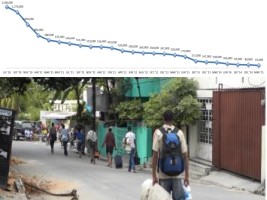15/04/2015 10:29:05
 |
More than 5 years after the January 12th 2010 earthquake, an estimated 16,230 households or 64,680 individuals are still residing in 66 IDP sites in the earthquake affected communes.
The affected communes, housing the IDP population, are mostly located in the metropolitan area of Port-au-Prince (which are the communes of Carrefour (4 sites), Port-au-Prince (21 sites), Delmas (15 sites), Cite Soleil (1 site), Petion-Ville (2 sites), Tabarre (5 sites) and Croix-des-Bouquets (4 sites)) as well as in communes situated in the Palms Regions, such as Léogâne (11 sites) (considered the epicenter of the earthquake) and Gressier (3 sites).
Communes such as Jacmel, Petit-Goave and Grand-Goave in the Palm Regions and Ganthier in the border region formerly housed IDP sites which have since closed.
As of 31st March 2015, the three communes with the highest IDP population are the following :
- Delmas, with the highest population of 7,263 IDP households (45% of the total households), corresponding to 27,914 individuals (43% of IDP individuals).
- Croix-des-Bouquets, the second largest with 2,283 households (14% of IDP households), corresponding to 10,636 individuals (16% of IDP individuals). It is important to note that the households residing in the camps known as Corail Sector 3 and Sector 4 are also included in the commune of Croix-des-Bouquets.
- Port-au-Prince, the third largest commune, with 1,755 households (11% of IDP households), corresponding to 6,114 individuals (9% of IDP individuals).
These three communes account for 70% of the IDP household population displaced by the 2010 earthquake. The remaining
communes in the metropolitan area of Port-au-Prince (Carrefour, Cite Soleil, Petion-Ville, and Tabarre) house 3,492 households (representing 14,429 individuals) and combined, account for 21% of all displaced households.
In the Palms regions, 1,245 IDP households (or 5,063 individuals) still reside in the commune of Leogane, whereas a reported 192 households (or 768 individuals) still reside in the commune of Gressier. These two communes now account for 9% of the total IDP caseload: Léogane represents 8% of the IDP population and Gressier represents 1%.
As of 31st March 2015, 66 sites remain open in Haiti. Consistent with previous reports, while Delmas continues to house the highest IDP population, Port-au-Prince remains the commune with the highest number of IDP sites, with 21 open sites (32% of the total of open sites.) It is followed by Delmas with 15 open sites (23% of total of open sites) and finally, Léogane (a commune in the Palms Regions) with 11 camps (17% of total open sites). Combined, these three communes account for 72% of all open sites.
When comparing the figures from this 22nd DTM to the IDP figures from 2010, a net decrease of 345,287 households (or 1,471,767 individuals) identified in 2010 can be observed. Furthermore, this also represents a decrease of 1,489 sites compared to July 2010, during the height of the internal displacement in Haiti.
When compared to the previous DTM release (December 2014), the number of IDP households decreased by 4,988 (representing 14,717 IDP individuals). This decrease is mainly due to ongoing relocation programs. However this decrease can also be attributed to an adjustment in displacement figures following detailed displaced household registrations, which allow for a precise count and profile of the displaced population. Of these 4,988 households, 1,671 households (representing 5,150 individuals) have left open sites either registered or where return programs are currently being carried out, while 3,322 households (9,506 individuals) have left camps which were closed. Subsequently, by the end of the current DTM reporting period, the number of IDP sites has been reduced by 39 out of which 38 camps were closed through return programs, while 1 closed due to spontaneous departure of IDPs.
Overall, the IDP household population decreased by 96% compared to the July 2010 figures and by 24% compared to the previous DTM report published in December 2014. Subsequently, the number of open IDP sites has also decreased by 96% compared to the July 2010 DTM, and by 37%, compared to the previous DTM report published in December 2014.
Over the course of the reporting period ending on 31st March 2015, 39 camps have been reported as closed. Return programs carried out by various partners have accounted for all closures during this period. A total of 4,988 households (representing 14,717 individuals) were relocated through assisted return programs. IDPs residing in one camp in Croix-des-Bouquets have spontaneously decided to vacate it, causing its closure. No camps were closed by evictions during this period.
This period, Port-au-Prince witnessed the largest decrease of the number of open sites with 33 camps closed by return programs as well as the largest decrease of households, with 2,599 households (representing 7,522 individuals) relocated by return programs. Three camps have closed in Delmas, with 549 households (or 1,402 individuals) relocated to better housing while two camps have closed in Carrefour (166 households or 545 individuals relocated). One T-shelter site in the commune of Croix-des-Bouquets, housing 8 households (representing 37 individuals) has closed due to the spontaneous departure of the IDPs; field assessments have determined that following many threats from the owner of the land were the camp is located, these IDPs decided to vacate it.
Of the 1,555 IDP sites and 361,517 households identified after the earthquake of January 12th 2010, 513 sites were closed by return subsidy programs (corresponding to 79,419 households or 268,669 individuals relocated to better housings).
Since 2010, a total of 14,444 households were evicted from 176 sites. Meanwhile, 251,424 households (or 1,142,528 individuals) have spontaneously left sites, resulting in the closure of 800 sites.
HL/ HaïtiLibre
No comments:
Post a Comment